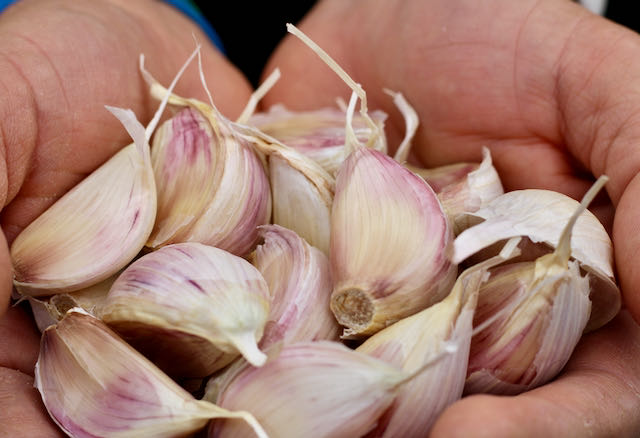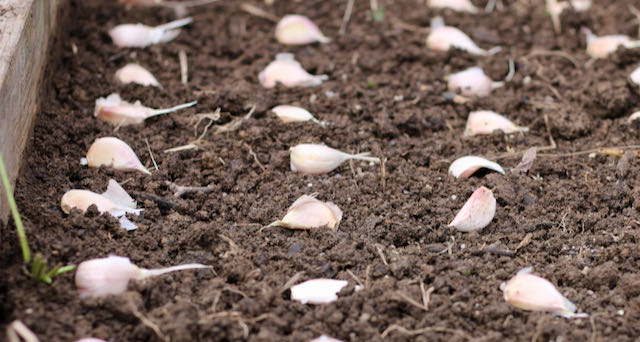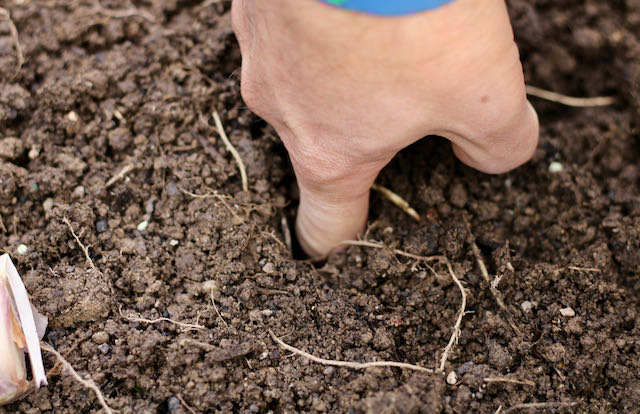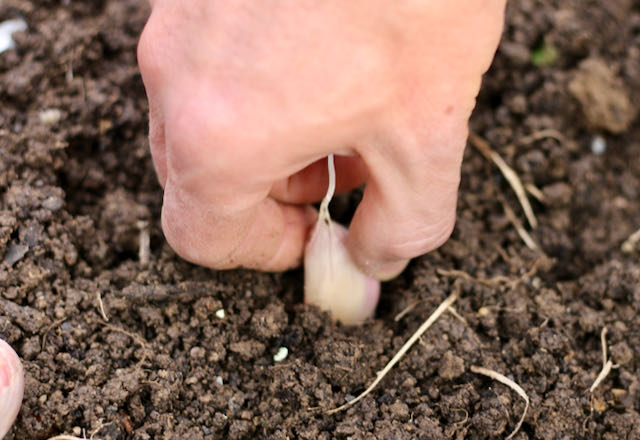Garlic is one of the easiest crops to grow. Plant garlic this fall, harvest it in the summer, and you will never have to purchase garlic again!

I can still remember my first season growing my own garlic. I was amazed that one garlic clove grew into an entire garlic bulb! Sounds pretty silly I know, but to be honest I never really gave it much thought prior to growing my own.
Although it took some patience, growing garlic required very little work. I was shocked at how simple it was!
I simply planted it in the fall. Left it alone for nine months with basically no watering and harvested a years worth of garlic. It really is that simple.
The best thing about growing your own garlic is that you can grow extra for planting in the fall and you will never have to purchase garlic again.
If you have never tried growing your own garlic, I hope you try it out and love it as much as I do.
Happy growing!
Where to Find Garlic for Planting
Lots of first time growers of garlic ask if they can plant garlic from the grocery store. The short answer is no or it is not recommended. Much of the garlic found in grocery stores is grown in China. This is problematic because it is often treated to stop it from sprouting. This means that it likely won’t grow. Also, it is grown in an environment that is likely different than yours which can also result in a poor crop.
It is best to try to find local, organic garlic that hasn’t been treated with any chemicals and is familiar with your local growing environment.
The best places to find local garlic is from a friend or neighbor that gardens, a local farmer’s market, or a local farm. Most garlic growers tend to grow quite a bit extra for planting themselves. This means that they can likely spare some for a friend or neighbor. Just start asking around, and you will likely find someone that will donate some to you. If not, call around to local farms and ask if they have any they would be willing to sell you.
If you are unable to find any locally, you will likely have a much better crop if you purchase some from an organic seed company rather than trying to grow some from the grocery store. Some of my favorites are:
Types of Garlic to Plant
There are two main types of garlic. They are hardneck and softneck garlic. There are various varieties that fall into each category. Without going into detail about specific varieties, I thought it would be helpful to understand the difference between hard and softneck garlic.
Softneck garlic is typically the kind you will find at your everyday grocery store. It typically will have more garlic cloves than hardneck varieties, but they are usually smaller in comparison. Softneck garlic tends to do better in warmer areas. It is also best for storing long term. If cured properly, it will last up to a year. It is also easy to store. Since softneck garlic has flexible stems, it can be braided together for easy storage.
Hardneck garlic is best for growing in cooler areas. It tends to produce fewer cloves, but they are typically bigger in comparison to softneck varieties. Hardneck varieties don’t store as well as softneck varieties. They typically last about 5-6months. Thick center stems make long term storage difficult. Due to their thick center stems they can’t be braided for easy storage. One benefit of hardneck varieties is that they grow a curved stalk called a scape which is a delicacy and can cost a pretty penny when purchasing at a farmer’s market. Once they curl, they should be removed from the plant so that they don’t steal energy that the plant needs for growing the bulb. Garlic scapes can be used in a variety of ways. My favorites are garlic scape pesto and simply sautéed with some eggs.
Whether you decide to grow hard or softneck varieties, you will notice that there isn’t much of a difference in overall taste. Both can be used in any number of ways that you use garlic. I tend to grow both varieties. I like the softneck varieties because they will last until my next garlic harvest, but I also love planting hradnecks for their larger cloves and delicious scapes.
When to Plant
Garlic is typically planted in the fall, around mid to late October. I live in hardiness zone 6a, and I typically plant mine at the end of October or early November. It should be planted at least a few weeks before the ground freezes so that the plant can start to develop its root system.
Garlic can also be planted in the spring If the fall planting is missed. Although it will grow, the overall harvest will likely not be as well as it could have been if it were planted in the fall. It is also likely that the bulbs will be smaller as well. However, if it comes down to a mediocre harvest or nothing at all then it is a good idea to plant in the spring if necessary.

How Much Garlic Should You Plant?
Knowing how much garlic to plant isn’t as hard to figure out as it might seem. Start by doing a quick calculation to figure out how many garlic bulbs your family uses in a typical week and multiply that by 52 weeks in a year. For example, my family typicaly eats about 3 bulbs each week, so that means that we need about 150 bulbs to eat for the year.
Next, figure out how many bulbs you will need to plant in the fall for your next crop? On average, there can be around 10 cloves per bulb. So planning to plant the cloves from about 20 bulbs will result in roughly 200 bulbs of garlic.
This is about what my family plants each year. It allows for enough garlic to eat for the year, enough to plant in the fall, and some extra for those that don’t grow or to give away. Obviously what works for my family, will likely be different than your family’s needs. In general, this is a quick and easy way to ensure that you have enough for eating, planting, and sharing.
Preparing Soil For Planting
It is best to prepare the soil before planting garlic by loosening the soil a bit and mixing in a few inches of compost. If you don’t have any compost that is ready, amend the soil with whatever you have. When I planted mine I didn’t have compost, so I added some organic fertilizer and some worm castings.
Preparing the Garlic
When preparing garlic for planting, carefully separate the cloves from the bulb. When separating, try not to remove the papery skin on the outside of the cloves. Next, sort through the cloves. Keep the larger cloves for planting and reserve any smaller cloves for cooking. By planting the larger cloves, it should result in larger bulbs at harvest time.
How to Plant Garlic
Spread the garlic cloves out in rows for planting. They should be planted about 4-6 inches apart so that they have enough room to grow.

Use the end of a shovel or your finger to make a hole about 2-3 inches deep for each clove.

Place a clove in each hole making sure that the pointed side is facing up. Then gently cover each hole.

If there is no rain in your forecast, give the garlic a good watering. Garlic should be watered at least once a week. However, aside from watering immediately after planting, I have never watered my garlic regularly. I tend to plant it and forget it.
Protecting Your Garlic
Mulch with chopped up leaves or hay. This will protect the garlic from very cold temperatures, keep the weeds out, and it will also break down over the winter and provide the soil with beneficial nutrients.
How Long Does It Take Garlic to Grow?
It takes about nine months for garlic to grow to maturity. It is typically ready to be harvested in mid-July. If you are growing hardneck garlic, it will produce garlic scapes that will be ready to harvest about a month earlier.
Leave a Reply